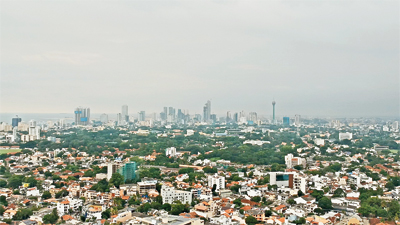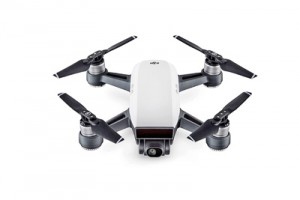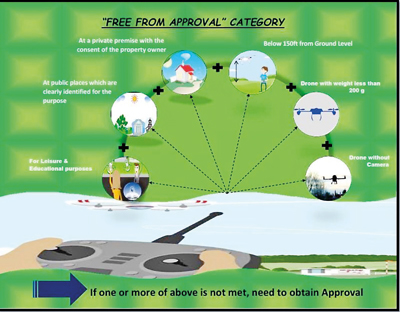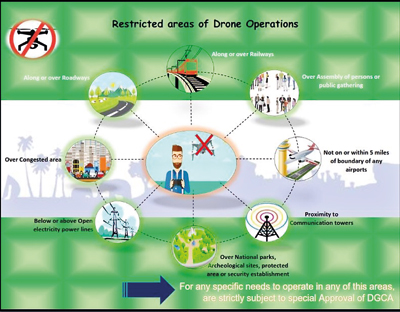Arts
Want to fly high with your own drone?
Thinking of getting yourself a drone? Drones or radio controlled (RC) aircraft seem to be everywhere these days. Simply stepping through Majestic City and Liberty Plaza, you will find a plethora of generic and Chinese name brand drones available at different price ranges and with features ranging from automatic stabilisation to collision warning systems and of course, cameras with a highlight on the ability to take epic selfies.

Colombo from above: Aerial photograph taken from DJI Spark drone
So does that mean you can simply walk into a shop, pick out a drone and fly it whenever and wherever? It’s not that simple: you need to operate these devices in a safe and legal manner.
After all they do carry some weight and we wouldn’t want them dropping out of the sky and injuring people on ground.
Most modern drones come well equipped and it is worth noting that the cheaper ones come with the least amount of technology and will be the hardest to fly. Investing in something a little more up the budget is highly recommended as with all the cool tech it comes with, there is also the safety aspect. To properly take advantage of these safety features one must first learn how to correctly set-up your drone for a flight. All this information is available in your owner’s manual and unlike other toys this one is a must-read. Remember, not all drones are the same and the features vary from brand to brand. Even if they are equipped with the same type of collision warning and avoidance systems, they always have their own unique way of operating. So take the time to read and understand. Different models of the same company may also work differently so for each and every device you own, you need to read the manual.
The next step would be to get it ready and fly right? Well no, it’s a little more complicated than that. Drones fly in the air so this means that they must operate according to the rules of the air. Over here we have the Civil Aviation Authority of Sri Lanka (CAA) that is responsible for our airspace and as such depending on the type of drone, you will need to see if your drone and potential flight path require you to receive prior permission and registration.

Pic courtesy of DJI
According to the drone information pamphlet available on the CAASL website (www.caa.lk) if your drone weighs 200 grams or less, does NOT have a camera, is for leisure and educational purpose, will be operating at 150ft or less, at a private premises with the consent of the property owner or at public areas clearly marked for the purpose, it would fall into the “Free from approval” category and as such you will NOT be required to register prior to flying. If not then you WILL BE required to register your drone with the CAASL.
The registration process shouldn’t take that long – we’d recommend giving it about a week to have you up and running. Now the other question would be the cost. How much? This all depends on the intended operation including type of flying and location. All the necessary information is available in PDF format over at the CAASL website but for a single event it is around Rs.4000 and for operation of more than 30 days in a calendar year it would be around Rs. 33,000.
Now that we know how we can legally fly, let us move onto the safety aspect and the dreaded ‘no fly zones’. Let’s state the obvious, drones are not yet waterproof, and we certainly do not recommend flights in the rain or in high wind conditions (this also reduces battery life as the motors work overtime to counter the wind and keep the aircraft stable).
The information pamphlet also clearly sets out areas forbidden for drone operations. They are: below or above electricity power lines as they can interfere with the drone’s compass and navigational equipment and also the transmitter making it hard to control or lead to the total loss of control; over congested areas; along or over roadways; along or over railways; over assembly of persons or public gathering; not on or within 5km boundary of any airports; proximity to communication towers and over national parks, archaeological sites, protected area or security establishments.
In addition to this it is worth noting that Colombo and its suburbs contain a couple of no-fly zones – this information is regularly updated on the CAASL website. Currently the permanent no fly zones would be a 2 km radius from the Parliament and other areas marked high security zones. A couple of other non-obvious flights that are not possible without prior approval would be night operations and operations from elevated surfaces such as rooftops.
In the end, yes, it is a lot of work just to be able to fly a drone, but that is how it should be. Even though these are consumer level equipment they are quite capable of causing injury to people on the ground and/or damage to property and as such you need to comply with the regulations. Moving with the mindset of our current society yes, it may be possible to get away without going through all this, but rules are rules, and these are set out for the safety of the general public (including yourself).
So you all you prospective drone pilots – head over to the links posted here and familiarize yourself. For those interested in a drone review we are currently testing out a DJI Spark as an entry-level drone so watch out for the review. Happy flying!

Drone information pamphlets courtesy CAASL

Check these out
Drone Operation information – https://www.caa.lk/index.php?option=com_content&view=article&id=731&Itemid=1550
Drone information pamphlet – https://www.caa.lk/images/stories/pdf/Drones/Drone_Information_Pamphlet_13_03_2018.pdf

